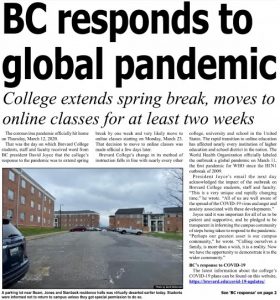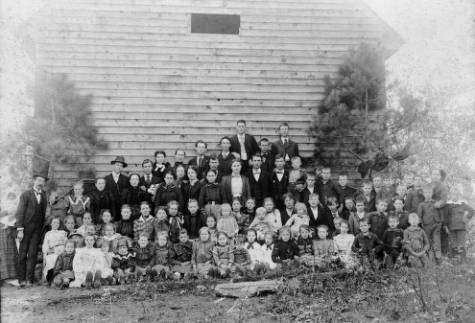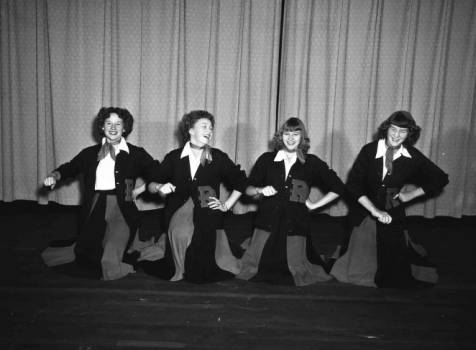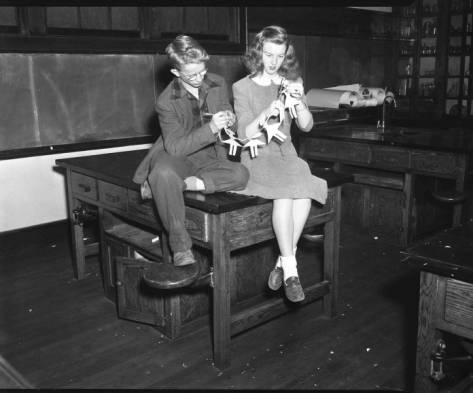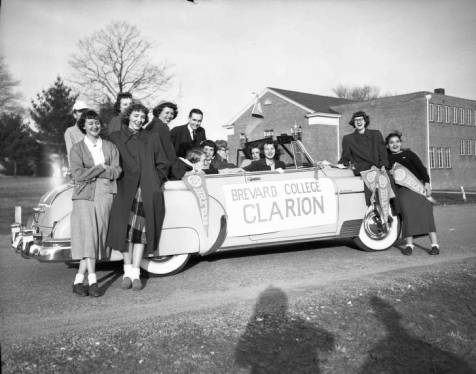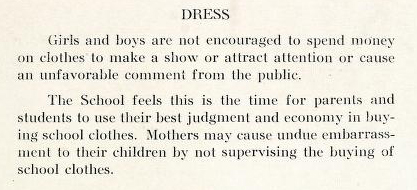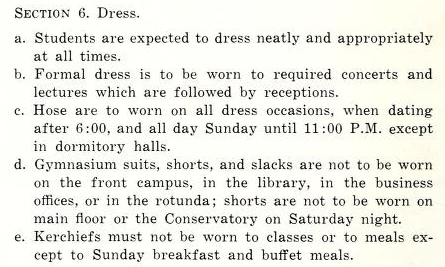
A few more issues of Brevard College‘s The Clarion have been added to our North Carolina Newspapers collection:
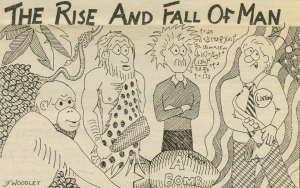
A cartoon from the April 19, 1993 issue
These issues cover several serious and political topics in addition to opinion pieces on student life and culture. Most notably, these newspapers cover the student views on former President Bill Clinton, who was elected in 1992.
In the November 10, 1992 edition, then-Assistant Editor Lorrin Wolf commented, “I want to move out of the United States because I feel that Clinton’s term will be a repeat of the Carter years.” Many of the students quoted in these issues expressed a similar sentiment.
You can see all available issues of The Clarion here. You can also browse all of our student newspapers by school name and location in our North Carolina Newspapers collection. To learn more about Brevard College, you can visit their partner page and their website.
Over 250 issues of The Clarion, the student newspaper of Brevard College located in Brevard, N.C., are now available on DigitalNC thanks to our partners at Brevard College. These additions span eight years, from June 2012 to May 2020. All of these issues are web editions and were distributed electronically.
Serving Brevard College since 1935, The Clarion speaks to the students on campus with articles focused on topics such as sports, clubs, events, commencement, and finals. Opinion pieces on popular news stories are also prominently featured. Injecting some fun into the routine, April Fool’s Day issues take on a satirical tone, changing their title to The Hilarion. Similarly, Halloween issues are retitled The Scarion.
As this upload includes issues from the beginning of 2020, present day readers might be interested in tracking the early articles on Covid-19 leading to the move to online instruction. Also of note is the tribute to the 2020 graduating class in the May 21, 2020 issue.
To see all of DigitalNC’s digitized content of Brevard College Student Newspapers going back to the first issues of The Clarion in 1935, click here. And to visit Brevard College’s homepage, click here.
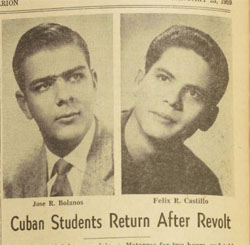 In the student newspapers from Brevard College that were recently digitized, we came across an interesting article from January 1959 about two Cuban students who were at home during the revolution that brought Fidel Castro to power. Here are a couple of excerpts:
In the student newspapers from Brevard College that were recently digitized, we came across an interesting article from January 1959 about two Cuban students who were at home during the revolution that brought Fidel Castro to power. Here are a couple of excerpts:
“The people of Cuba are rejoicing about the overthrow of the Batista government and the success of the popular rebel leader, Fidel Castro. ‘Viva Fidel’ is the cry of the people. These observations are from two Brevard college students who have just returned from their Christmas holidays spend at their homes in Cuba.”
“Both students expressed belief that the Castro government will be the most liberal in Cuba’s history. They denied emphatically that the rebel group was in any way communist controlled.”
Apparently there were, at the time, several students from Cuba attending the small college in the North Carolina mountains.
The small town of Brevard has lately received a lot of attention here at the North Carolina Digital Heritage Center. Following last week’s announcement about the digitization of early issues of the Sylvan Valley News, I’m pleased to announce that a long run of historic student newspapers from Brevard College is now available online.
Over 700 issues of student-produced papers from Brevard College as well as predecessor schools Weaver College and Rutherford College can now be searched and browsed online. The papers range in date from to 1924 to 2006, and are a fantastic resource for studying student life in a small mountain college throughout the 20th century.
These digital versions were created from original newspapers held in the
Brevard College Archives, located in the James A. Jones Library.
Student yearbooks from Brevard College are now available on DigitalNC.
The online collection includes a few yearbooks from two of the schools that preceded Brevard College: Weaver College and Rutherford College.
The Brevard yearbook has been called “The Pertelote” since 1935, the name coming from “The Nun’s Priest’s Tale,” one of the Canterbury Tales by Geoffrey Chaucer, and referring to the relationship between Brevard and Duke University. The editors of the 1935 volume write, “The name of this book signifies our relationship to our big brother, Duke University. The title of Duke’s annual is ‘The Chanticleer’. In Chaucer’s old tale, Pertelote was the hen most loved by the valiant Chanticleer. So, since we are in various ways connected with Duke, and particularly of the same religious denomination, we elected to call our annual The Pertelote.”
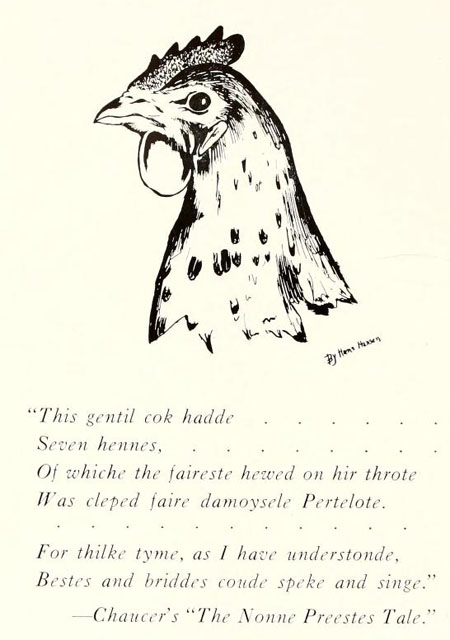
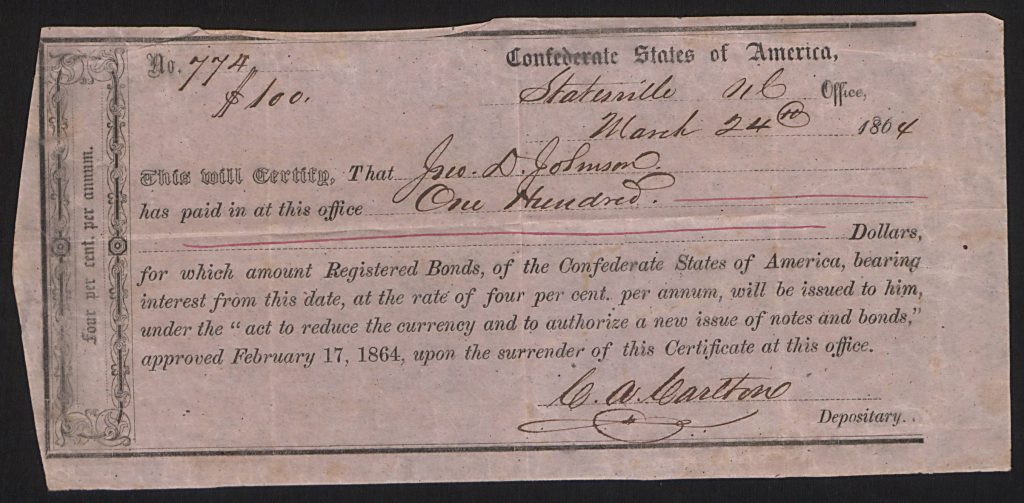
A bond certificate addressed to Jonathan D. Johnson, who purchased $100 Confederate dollars in March 1864.
Over three dozen 19th century and early 20th century Presbyterian Church sermons delivered by Robert Zenas Johnston are now digitized and available on DigitalNC. Also included are reports from 19th century Presbyterian Churches, documents from Rufus Johnston, and correspondence from Mary Gibson, both citizens of Mecklenburg County. All of these documents come to DigitalNC courtesy of our partner, Davidson College as part of their Andrew W. Mellon Foundation funded “Justice, Equality, Community: Reimagining Humanities Curricula” project, which is a three-year, campus-wide initiative. All materials digitized for the project by DigitalNC can be found on the exhibit page Nineteenth Century Family Papers and Plantation Records of Davidson College Trustees.
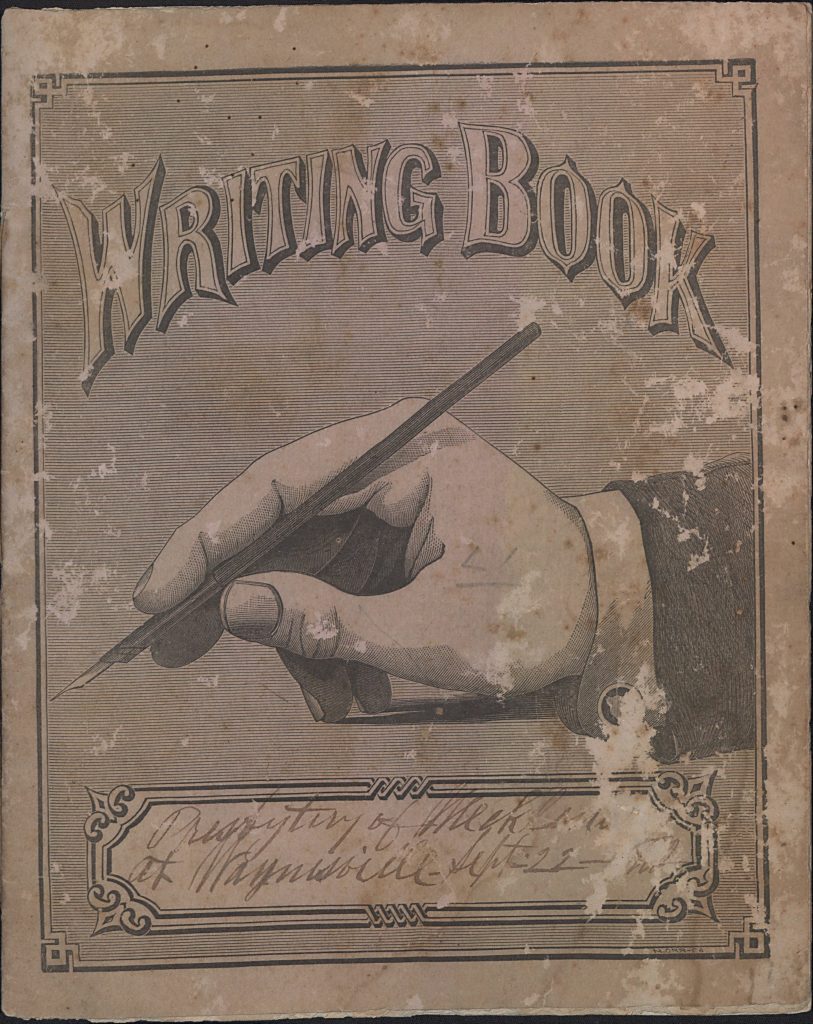
The cover of one of the notebooks used by the Presbyterian Churches of Mecklenburg County, made in roughly 1876.
Johnston’s sermons (over 550!) stretch from 1859 to 1907, until just before his death in 1908. He delivered them all across the state, from Asheville to Shelby, in different cities around Mecklenburg County, and even at the Unity Church in South Carolina. Approximately 61 of those sermons are undated, but they most likely date from the 1800s as well. In many of the earlier sermons, he discussed the Civil War on the local towns. We also have several of his student notebooks, a contract for a teaching position and pastoral position that Johnston was offered, and more.
Also included in this new collection of documents are financial records of Rufus Johnston, including receipts, bonds, and bills of payment. We also received correspondence and letters from Mary Gibson, one of which tells her brother Robert what she would like done with her property towards the end of the Civil War.
Another folder contains a few documents about Davidson College itself. One document was written by Reverend Jethro Rumple, reminiscing about life at the college in the 1840’s. Included is a small handwritten biography by Reverend Rumple about Reverend John Bunyan Shearer, the eighth president of Davidson College from 1888 to 1901. These documents help give us all a greater idea of what living as a student in those times was like. Also included in this batch is a letter written by Rumple to Brother McLaughlin about an 1878 Concord Presbytery Meeting in Statesville, North Carolina.
This collection also includes various reports to and about Presbyterian Churches across the state. A few letters are addressed to synods, while others are reports on new developments within the church. There are also several notebooks, copybooks, and ledgers used by the church.
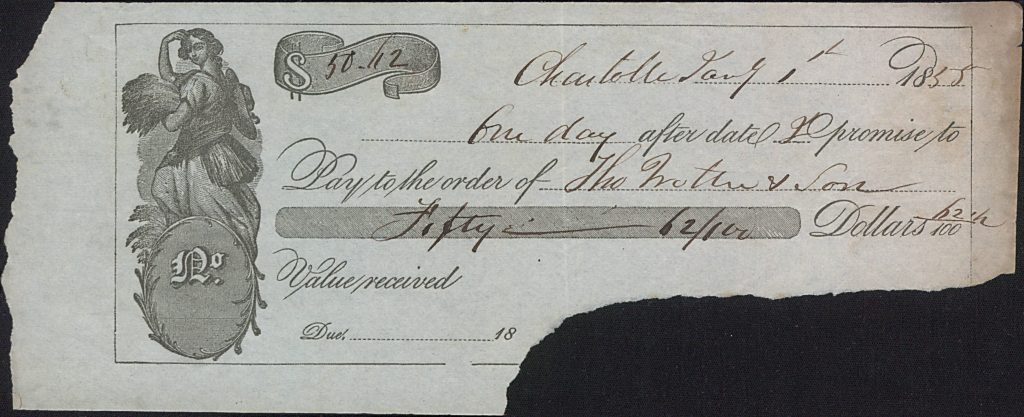
An 1855 receipt from Rural Hill Plantation promising payment of $50.12 due the next day.
Finally, DigitalNC also received folders of papers and documents about several Mecklenburg County plantations. Stretching from the 1820s to the 1860s, many of the folders contain financial records and receipts from Rural Hill, a plantation in Huntersville that was built in 1788 by Major John Davidson. There are also documents from his grandson, Adam Brevard Davidson, who later became a Trustee of Davidson College, and financial records, ledgers and booklets from the Mt. Tirzah Plantation in Lincoln County.
To browse through these materials, feel free to visit Davidson College’s partner page, or check out their website.
Mascots are a complicated phenomenon. They inspire a spectrum of reactions: ridicule, ambivalence, or fierce loyalty. With thousands of yearbooks online, all of us here at the Digital Heritage Center have probably spent more time looking at yearbooks than anyone else you’re likely to meet. Mascots are a common theme.
I’ve been working on today’s post for quite some time; unable to find a history or comprehensive list of mascots in North Carolina I decided to compile one myself. So here’s a stab at a college mascot overview, drawn from yearbooks and other campus publications. Let me know what I’ve missed or gotten wrong!
Children
In the early 20th century, schools frequently chose children as mascots or sponsors, whether for a sports team or for a particular class. The earliest example we’ve found on DigitalNC is from a 1910 publication by Atlantic Christian College (now Barton College) in Wilson, which shows Elizabeth Settle Caldwell as the Senior Class sponsor.
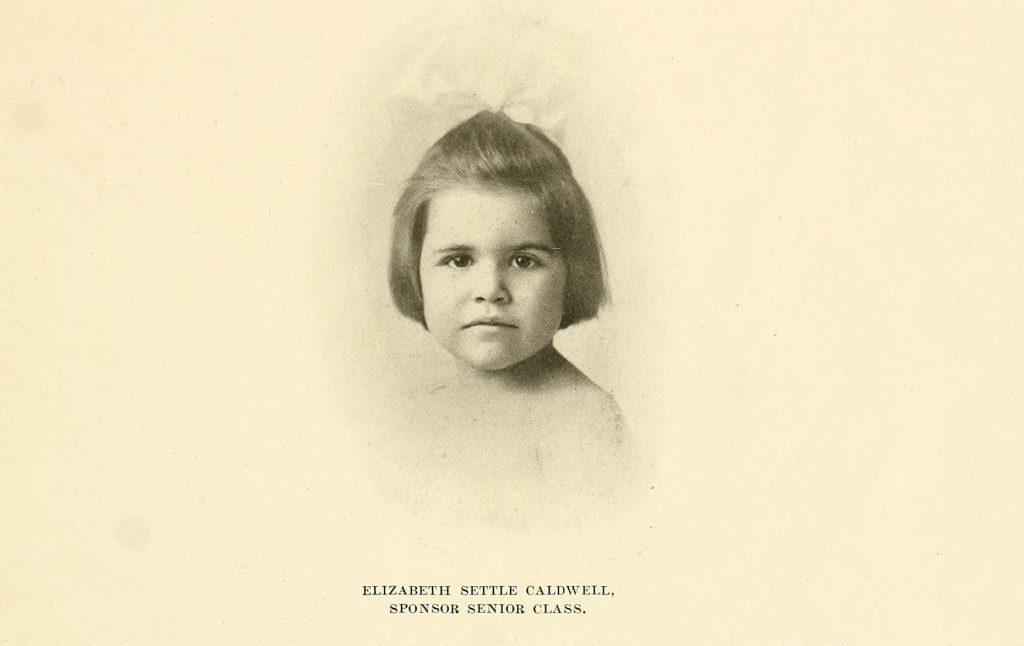
Elizabeth Settle Caldwell, First North Carolina Mascot? From the 1910 Pine Knot yearbook, Atlantic Christian College.
Ms. Caldwell was the daughter of Jesse Cobb Caldwell, the college president. From what we’ve been able to tell, children mascots were frequently younger siblings of students, teachers, or others associated with the school. Students mention that Ms. Caldwell brought “solace to many a lonely, homesick heart” and this may be why children were chosen – to foster a feeling of family and comfort among students. We’ve seen several references to mascots being elected or being chosen through competition, although what this might be we haven’t been able to discover. The trend of choosing children as mascots seems to continue through the 1960s. The latest one we found is Dawn, the Senior Class mascot at Peace College (now William Peace University) in 1966.
Animals
Animal mascots span schools across the state, whether it’s Rameses at UNC-Chapel Hill or WCU’s Catamount. The bulldog and different types of cats win out as most frequently adopted. Pictures of live animal mascots start to appear in yearbooks in the early 1900s, and continue today although much less frequently. For a variety of reasons, including concerns expressed by animal rights activists, schools have shifted away from actual animals to students dressing up like animals, as you’ll see later on in this post.
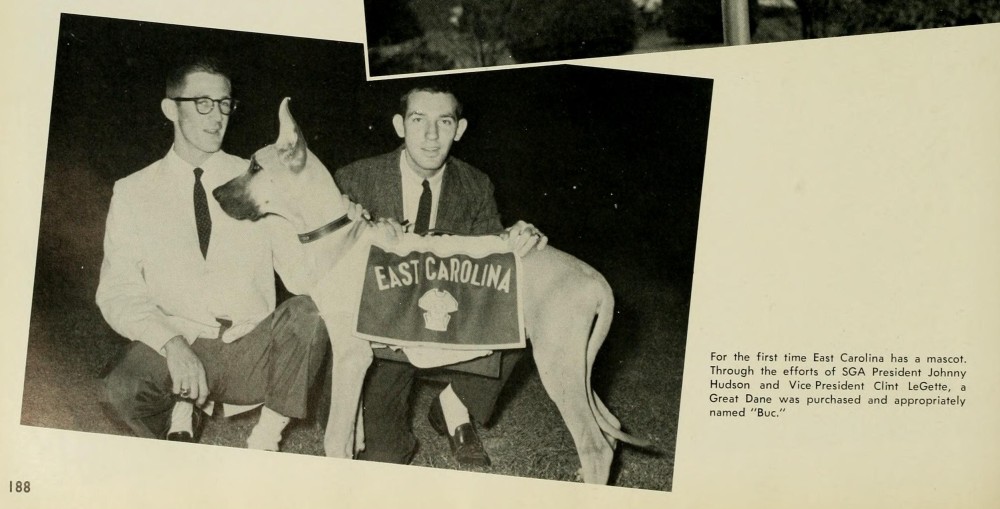
“Buc” is described here as East Carolina University’s first mascot. From the 1959 Buccaneer yearbook.
Characters
While about half of the four-year college mascots in North Carolina are animals, most of the others are characters that are historic, mythical, or extraordinary in nature. From what I’ve seen in NC yearbooks, humans dressing up as the school mascot really got traction in the 1960s. Initially, these costumes weren’t the fuzzy creations we think of today, but rather less complicated ensembles where the mascot’s identity (his or her face and body) was often apparent. Yosef the Mountaineer, beloved icon of Appalachian State University, was created sometime around 1942 and looked like this in the 1960s:
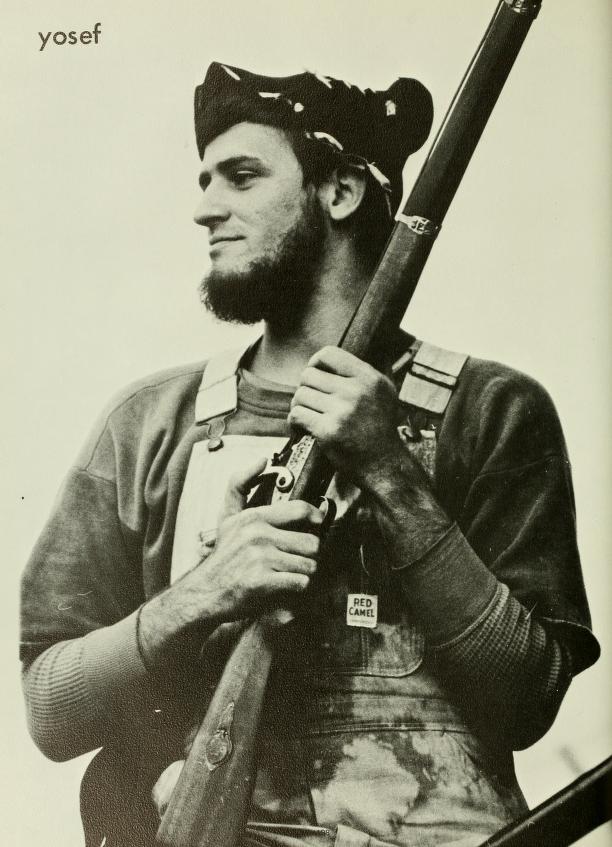
Yosef the Mountaineer, aka James Randle Tedder (we think). From the 1969 Rhododendron yearbook, Appalachian State University.
One of my favorites has to be this picture of Duke Blue Devil, from 1950:
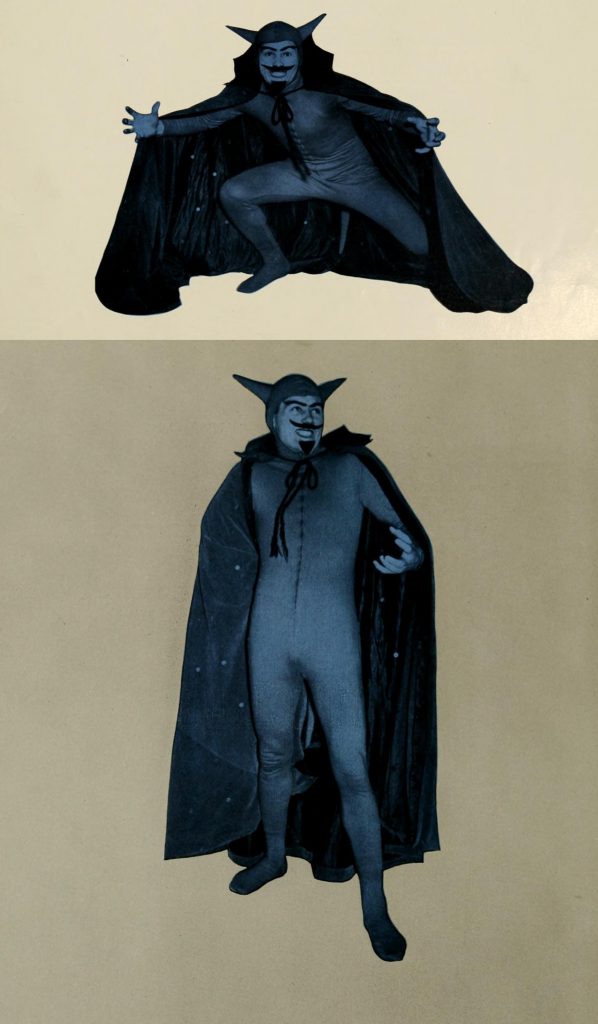
The Blue Devil. From the 1950 Chanticleer yearbook, Duke University.
Perhaps it was too hard to maintain a degree of consistency as students graduated over the years, and mascot anonymity seemed like a better idea. Whatever the reason, you start to see fuzzy, oversized costumes with gigantic headpieces in the late 1970s.
The Big Costumes
Whether animal or character, plush mascots that include a single piece body suit with a large plastic or cloth-covered head is something most Americans can identify with, thanks to professional sports. Colleges in North Carolina really embraced these costumes through the 1980s. Here’s what the UNC-Wilmington Seahawk looked like in 1987:

The Seahawk. From the 1987 Fledgling yearbook, UNC-Wilmington.
Some schools have developed multiple mascots dedicated to different audiences. It seems like the difficulty with these types of costumes is how to pull off a fierce facial expression that doesn’t come off as goofy or too scary for children. I think this picture from Davidson College sums it all up:
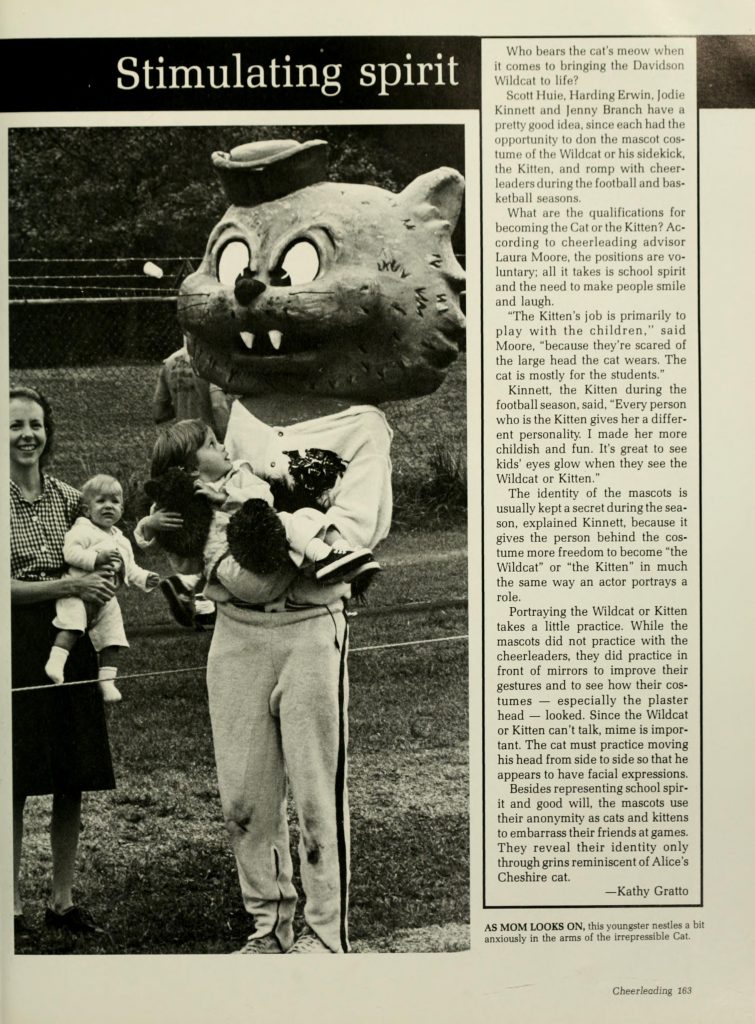
The Davidson Wildcat and … friends. From the 1983 Quips and Cranks yearbook.
I will also take this opportunity to mention a mascot that routinely makes the “wait … what?” list – the Campbell University Fighting Camels:
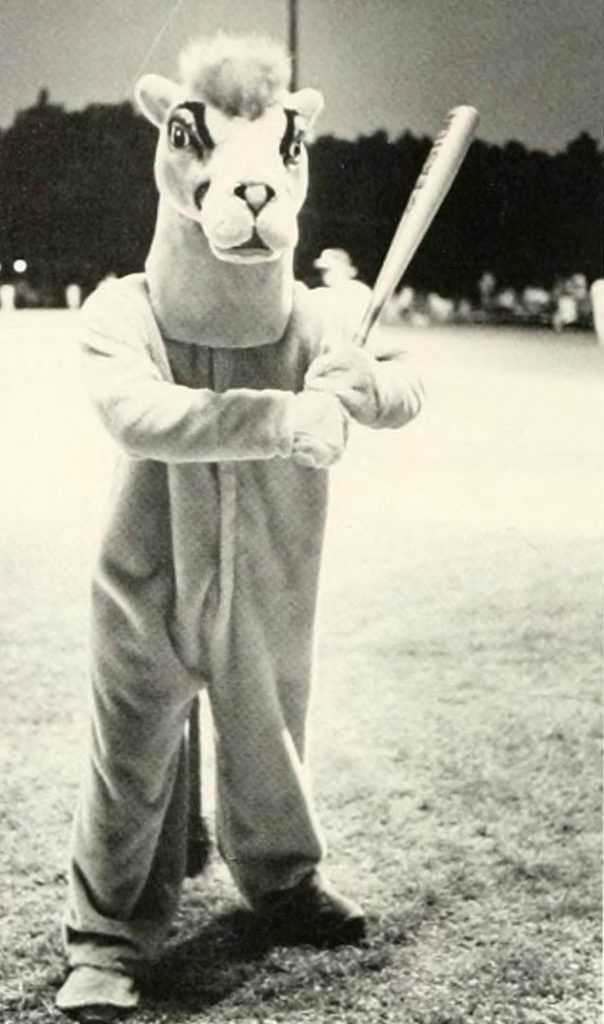
The Campbell Camel. From the 1983 Pine Burr yearbook.
Even the humans and human-like creatures are clothed in oversized costumes these days. Wake Forest University’s Deacon is a dapper chap:
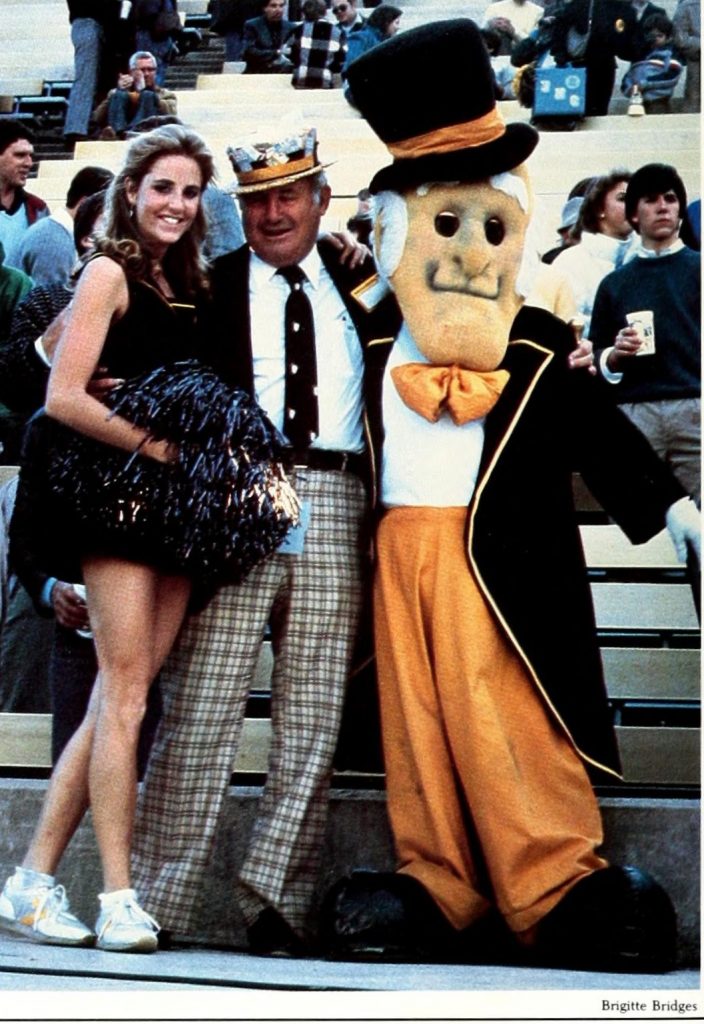
Wake Forest’s Deacon poses with fans. From the 1985 Howler yearbook.
In addition to the Demon Deacons and the Blue Devils, North Carolina boasts a number of other spiritual mascots: North Carolina Wesleyan’s Battling Bishops, Belmont Abbey’s Crusaders, and Guilford College’s Quakers. Meredith College’s teams are known as the Avenging Angels (formerly just the Angels). While Elon University’s mascot is now the Phoenix, before 2000 they were the Fighting Christians:
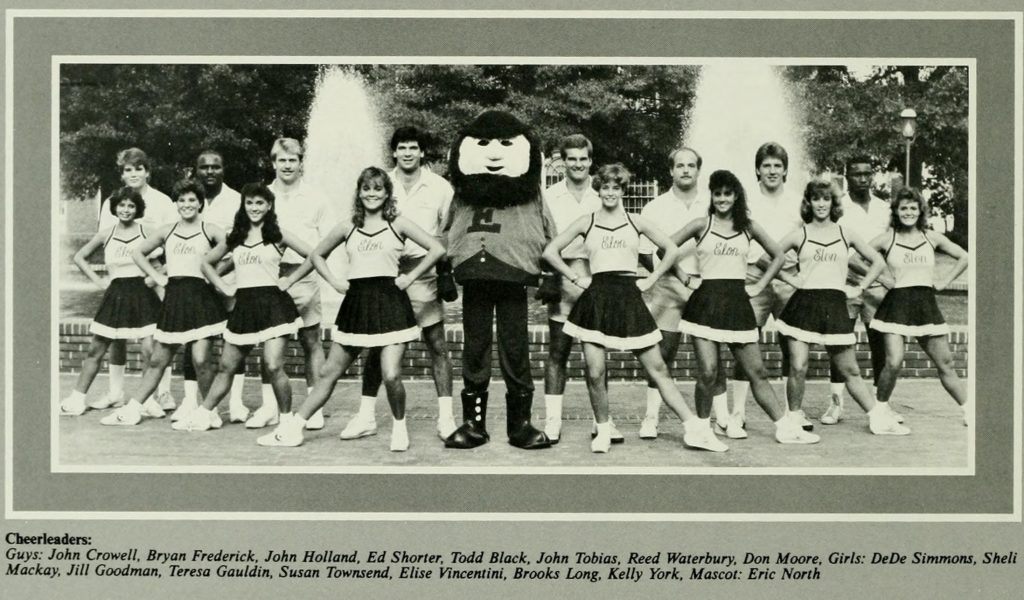
The Elon Fighting Christian mascot with cheerleaders. From the 1986 Phi Psi Cli yearbook.
Two schools break with the animal/human tradition in North Carolina. The Brevard College Tornadoes and the Louisburg College Hurricanes. Weather phenomena mascots are always difficult to pull off. I couldn’t find one for Brevard, but Louisburg, which currently has a bird mascot, had “Louie” up until 2006:
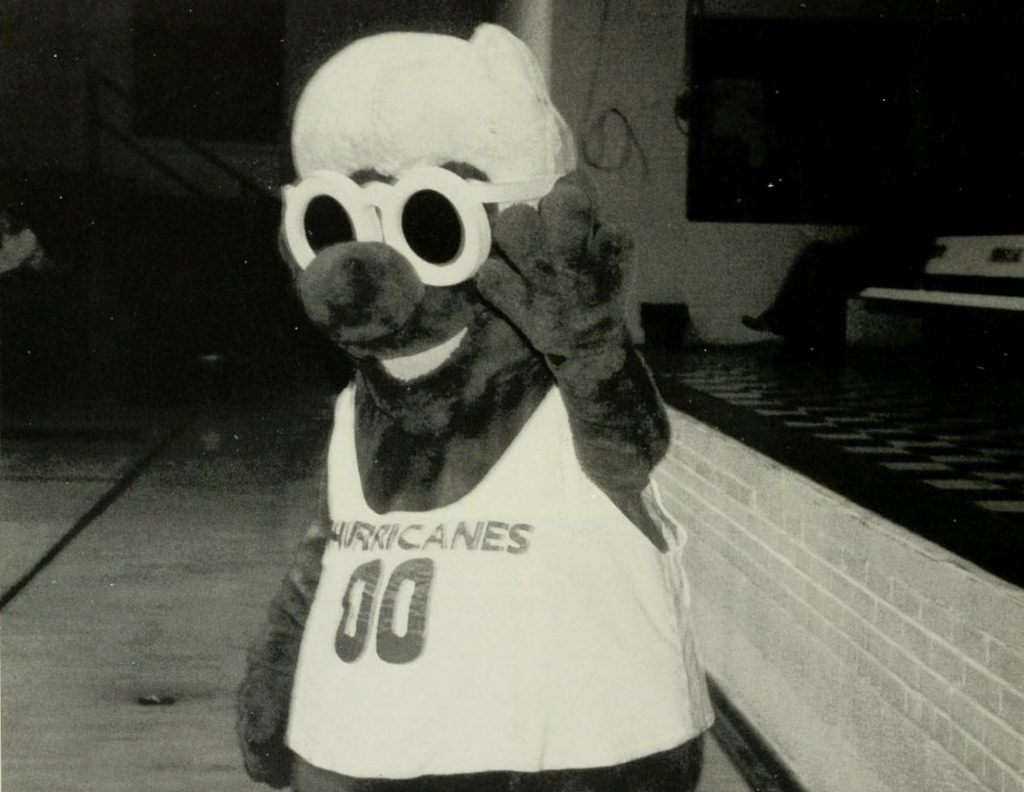
Louie, the former Louisburg College Hurricanes mascot. From the 1996 The Oak yearbook.
Who knows when the next mascot sea change will happen. Below is a list of mascots in North Carolina; let us know if we got anything wrong. Which one is your favorite?
| School |
Mascot |
Notes |
| Appalachian State University |
Yosef the Mountaineer |
First appeared in the yearbook in 1942 |
| Barton College |
Bulldog |
|
| Belmont Abbey College |
Crusader |
|
| Bennett College |
|
Known as the Bennett Belles |
| Brevard College |
Tornado |
|
| Campbell University |
Fighting Camels |
The Hornets in the 1920s-1930s |
| Catawba College |
Catawba Indian |
|
| Chowan University |
Hawks |
The Braves until 2006 |
| Davidson College |
Wildcats |
Also a bulldog (1929) and a bobcat (1939) |
| Duke University |
Blue Devil |
|
| East Carolina University |
Pirates |
Formerly Pee Dee the Pirate |
| Elizabeth City State University |
Vikings |
|
| Elon University |
Phoenix |
The Fightin’ Christians until 2000 |
| Fayetteville State University |
Broncos |
|
| Gardner-Webb University |
Runnin’ Bulldogs |
|
| Greensboro College |
The Pride |
Formerly the Hornets |
| Guilford College |
Quakers |
|
| High Point University |
Panthers |
|
| Johnson C. Smith University |
Golden Bulls |
|
| Lees-McRae College |
Wily the Bobcat |
|
| Lenoir-Rhyne University |
Joe and Josie Bear |
|
| Louisburg College |
Hurricanes |
|
| Mars Hill College |
Mountain Lion |
|
| Meredith College |
Avenging Angels |
Formerly the Angels |
| Methodist University |
Eagles |
|
| Montreat College |
Cavaliers |
|
| Mount Olive College |
Trojans |
|
| North Carolina A&T |
Aggie Dog (Bulldog) |
|
| North Carolina Central University |
Eagles |
|
| North Carolina State University |
Wolfpack |
|
| North Carolina Wesleyan College |
Battling Bishops |
Formerly the Circuit Riders |
| Peace College |
Pacer |
|
| Pfeiffer University |
Falcons |
|
| Queens University of Charlotte |
Rex the Royal |
|
| Saint Augustine’s University |
Mighty Falcons |
|
| Salem College |
Spirits |
|
| Shaw University |
Bears |
|
| St. Andrews University |
Knights |
|
| UNC Asheville |
Bulldog |
|
| UNC Chapel Hill |
Rameses the Ram |
Also known as the Tar Heels |
| UNC Charlotte |
Norm the Niner |
|
| UNC Greensboro |
Spartans |
|
| UNC Pembroke |
Braves |
|
| UNC Wilmington |
Seahawk |
|
| UNC School of the Arts |
Fighting Pickle |
|
| UNC School of Science and Math |
Unicorn |
|
| Wake Forest University |
Demon Deacons |
|
| Warren Wilson College |
Owls |
|
| Western Carolina University |
Catamount |
“Paws” |
| Wingate University |
Bulldog |
|
| Winston-Salem State University |
Ram |
|
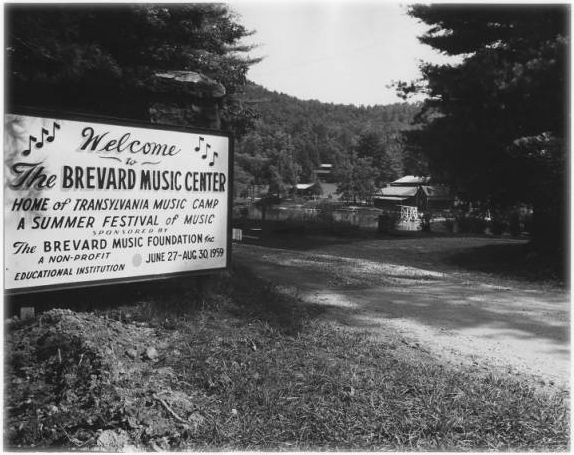
Entrance to Brevard Music Center, 1959
The North Carolina Digital Heritage Center has added another new partner, the Brevard Music Center. Materials from the Center that are now available online include photographs that date back to the Center’s origins as a music camp at Davidson College and every issue of Overture, the program for the camp and festival that has occurred every year since 1945.
Brevard Music Center was started by James Christian Pfohl as Davidson Music School for Boys in 1936. The school moved to it’s present location in Brevard in 1944 and became coeducational and named the Transylvania Music Camp. In 1946, a music festival was added along to the summer camp and in 1955 the school and festival became the Brevard Music Center. Over the years has trained hundreds of students in music, from playing instruments to singing. Many big names have played at the Center, including Midori Ito and its’ current artistic director, Keith Lockhart. The NCDHC is excited to add such an important part of North Carolina’s music education history to DigitalNC for a wide audience to enjoy.
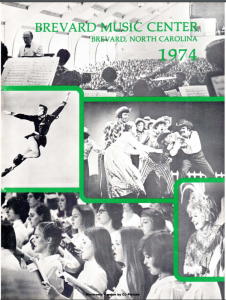
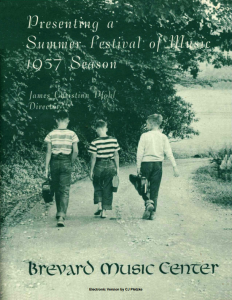
To learn more about the Brevard Music Center and view the resources that have been digitized, visit their contributor page here.
More than 500 photographs contributed by Transylvania County Library have been added to the Images of North Carolina collection on DigitalNC. Many of these images center upon school life in Transylvania County, from rural schools of the early twentieth century to Rosman High School, Brevard High School, and Brevard College. These photographs complement earlier contributions of photographs by Transylvania County Library that feature scenes of community life.
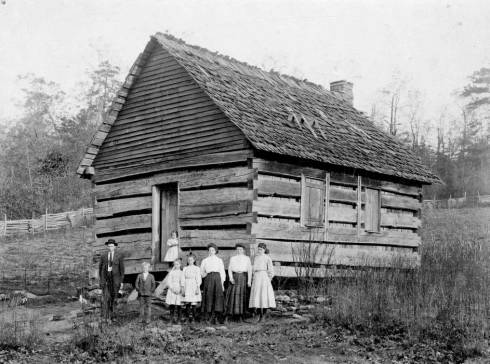
Quebec School Number One, before school taxes.
Lakeside School (also known as Hogback Valley or Pea Ridge).
Rosman High School cheerleading, February 2, 1954.
Brevard High School, Most Original Robert Hunter and Carolyn Kizer, 1947.
Brevard College, Clarion Loyalty Campaign.
Course catalogs, student handbooks, and other campus publications from a number of institutions — including Brevard College, Campbell University, Chowan University, the College of the Albemarle, Davidson College, Elizabeth City State University, North Carolina Wesleyan College, and St. Andrews University — have been added to the North Carolina College and University Yearbooks collection. These materials, many of which date back to the nineteenth century, aren’t just about the course offerings and descriptions – they often include detailed information about admissions, tuition, campus policies, institutional history and mission, and student life.
I’ve especially enjoyed reading the various rules and regulations laid out in these volumes. Most of them apply to female students, and seem to be aimed at thwarting “improper” behavior. Some of my favorites are below.
Regarding dress:
Regarding behavior:
And, of course, regarding guns:



